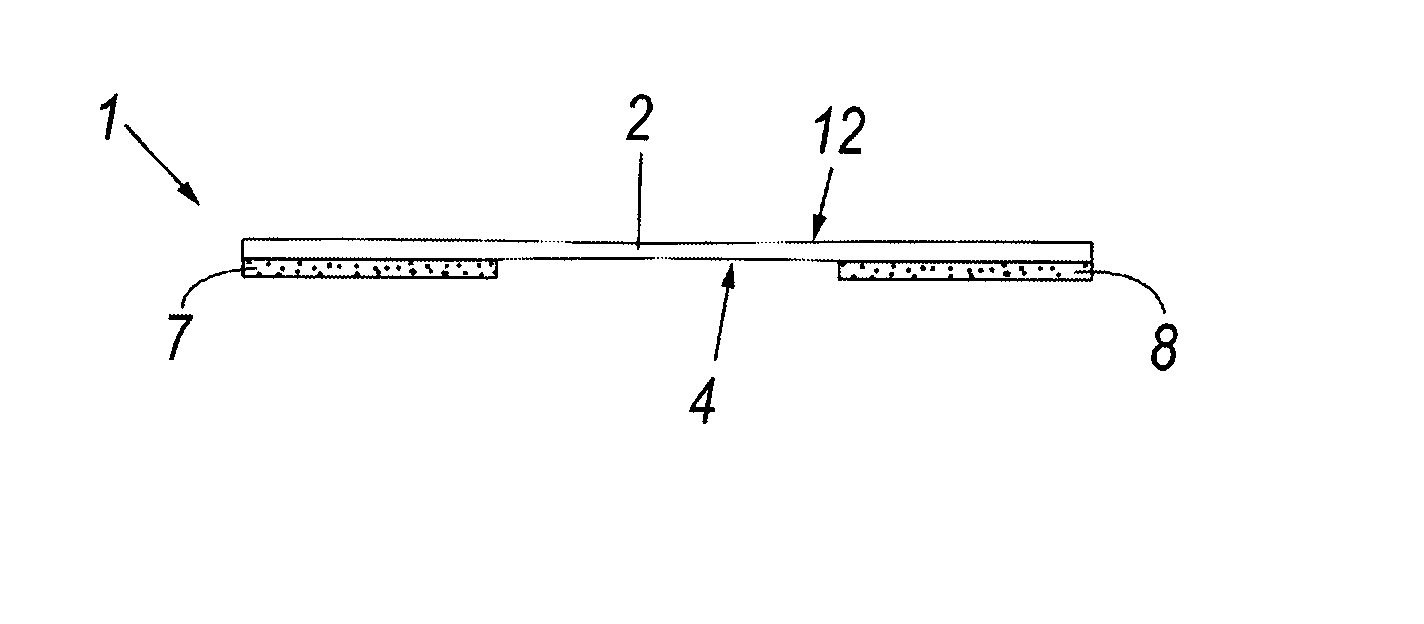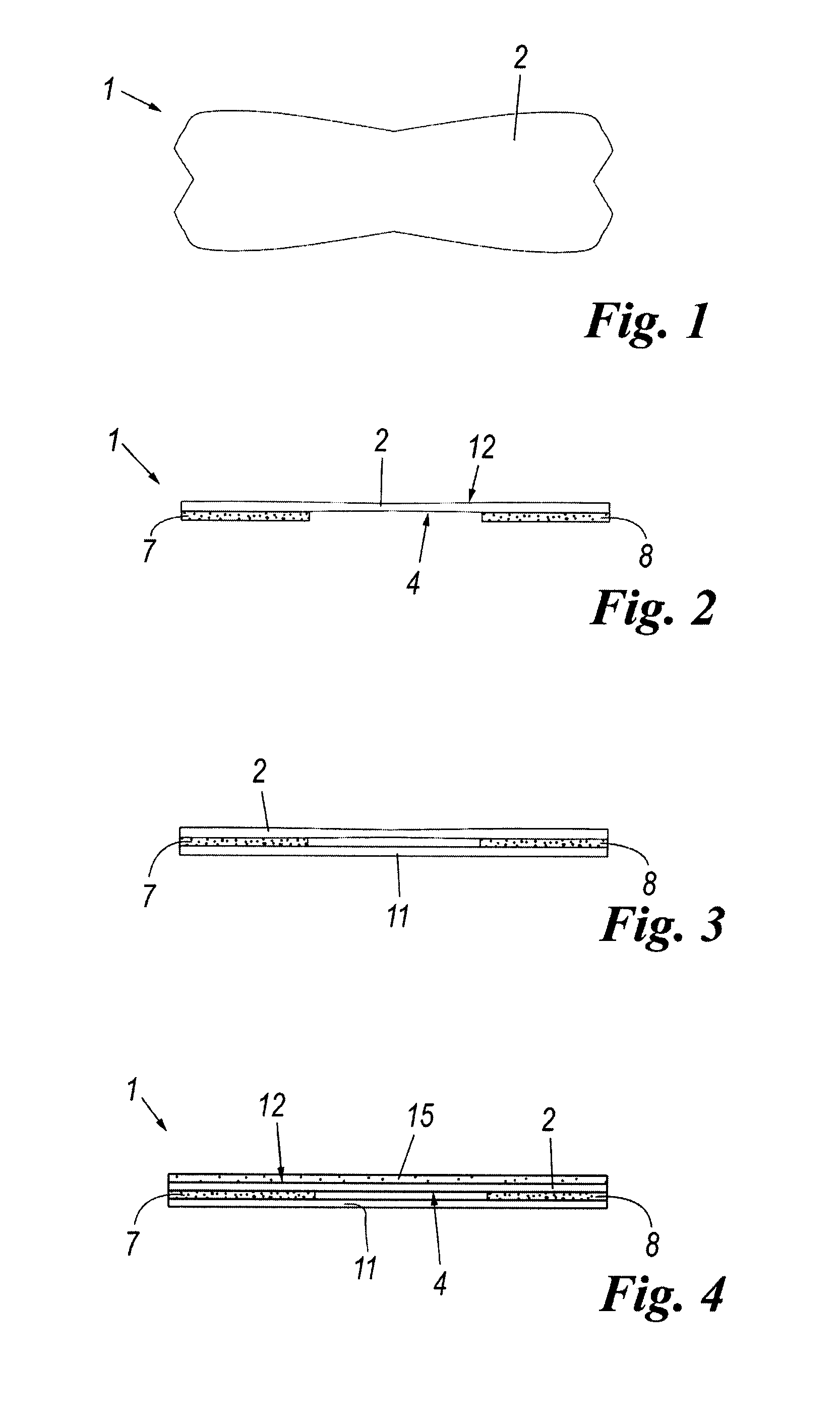Nasal dilator
- Summary
- Abstract
- Description
- Claims
- Application Information
AI Technical Summary
Benefits of technology
Problems solved by technology
Method used
Image
Examples
example 1
[0032]Preparation of a Nasal Dilator Comprising a Polyester Lamina of 100 Micron Thickness.
[0033]15.18 kg of solvent based acrylic adhesive (for example adhesive produced and sold under the name Durotak 2819 of National Starch & Chemical Co.) are fed cold into a container.
[0034]Using a patch spreading machine and with the aid of a compressed air pump the acrylic adhesive mixture is transferred onto the rotating cylinder doctor, having adjusted the doctor thickness to about 200 micron.
[0035]The doctor spreads the adhesive (to the set thickness) onto a continuous plastic web.
[0036]To form nasal dilators having only their ends provided with the adhesive layer, the adhesive is prevented from being spread over the entire surface of the plastic lamina by providing the doctor (in known manner) with dividers to form numerous doctor scrapers, each of which deposits on the plastic lamina a 40 mm band of adhesive, leaving 20 mm free of adhesive. Deposition continues for the entire length of th...
example 2
[0043]Preparation of a Nasal Dilator Formed with a Polyester Lamina of 150 Micron Thickness.
[0044]30 kg of water based acrylic adhesive (methyl acrylate polymer—for example adhesive known by the registered name ACRONAL-500 D adhesive) are fed cold into a container.
[0045]The preparation proceeds as indicated for example 1.
[0046]Using a patch spreading machine and with the aid of a compressed air pump the adhesive is transferred onto the rotating cylinder doctor, having adjusted the doctor thickness to about 200 micron; by means of the doctor the adhesive is applied to a web of plastic material.
[0047]To prevent the adhesive from being spread over the entire surface of the web, various doctor scrapers are formed, each of which deposits a band of 40 mm of adhesive, leaving 20 mm free of adhesive, and so on for the entire width of the polyester web having a thickness of 150 micron polyester.
[0048]The adhesive spread in bands on the polyester web passes through 4 oven stations, the first ...
example 3
[0053]Preparation of a Nasal Dilator Formed with a PVC Lamina of 200 micron thickness.
[0054]50 kg of solvent based acrylic adhesive (for example Duro-tak-280A adhesive of National Starch & Chemical Co.) are fed cold into a container.
[0055]The preparation proceeds as indicated in Example 1, but adjusting the doctor thickness to about 360 micron and spreading the adhesive on a PVC web of 200 micron thickness and then passing the adhesive spread on PVC through four oven stations, the first being controlled at 60° C., the second at 70° C., the third at 80° C. and the fourth at 90° C., with a speed of 8 metres per minute.
[0056]At the oven exit the adhesive is completely free of solvents, which have evaporated in the oven stations; the thickness of the adhesive mass is about 50 g / m2.
[0057]The PVC is then coupled to siliconized paper of 80 g / m2 and rewound into a reel. The result is that the adhesive layers, pressed and protected by the siliconized paper, bind to the PVC.
[0058]The reel obt...
PUM
 Login to View More
Login to View More Abstract
Description
Claims
Application Information
 Login to View More
Login to View More - R&D
- Intellectual Property
- Life Sciences
- Materials
- Tech Scout
- Unparalleled Data Quality
- Higher Quality Content
- 60% Fewer Hallucinations
Browse by: Latest US Patents, China's latest patents, Technical Efficacy Thesaurus, Application Domain, Technology Topic, Popular Technical Reports.
© 2025 PatSnap. All rights reserved.Legal|Privacy policy|Modern Slavery Act Transparency Statement|Sitemap|About US| Contact US: help@patsnap.com


